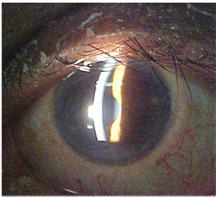 History
History
A 63-year-old black male presented, on referral from his general physician, with a chief complaint of foreign-body sensation that has persisted for two months.
He reported that he experienced this ocular complaint before, but did not seek help or treatment. His systemic history included hypertension and arthritis, for which he was being properly medicated.
Diagnostic Data
His best-corrected visual acuity was 20/30 O.U. at distance and near. External examination was normal, and there was no evidence of afferent pupillary defect. The pertinent anterior segment findings are illustrated in the photograph.
The patients intraocular pressure measured 19mm Hg O.U. The dilated fundus examination was unremarkable.
Your Diagnosis

Biomicroscopy of a 47-year-old patient complaining of foreign-body sensation revealed these findings.
How would you approach this case? Does this patient require any additional tests? What is your diagnosis? How would you manage this patient? Whats the likely prognosis?
The Diagnosis
The diagnosis in this case is trichiasis, an inward turning of the eyelashes. Additional testing may rule out the presence of hordeolum, chalazion, ectropion, entropion, blepharitis, or maderosis secondary to sebaceous cell or gland carcinoma.
Trichiasis is typically an acquired condition in which the eyelid cilia are misdirected toward the ocular surface.1-4 This usually results from inflammatory disruption and scarring of the eyelash follicles, but may also be secondary to eyelid positional abnormalities.1 Underlying inflammatory processes may involve both lamellae of the eyelid, producing an entropion.1 While it has no sexual predilection, anecdotally, there is evidence suggesting that it occurs more frequently in patients possessing naturally or acquired narrow palpebral apertures.
Treatment is based on the number, distribution and severity of the misdirected cilia. The easiest treatment is to instruct the patient on how to train the eyelashes up and away from the corneal surface. This can be done manually, using the fingers, by curling the lashes away from the ocular surface. Other treatment modalities include epilation, electrolysis, radiofrequency ablation, laser photoablation, cryotherapy to the posterior eyelid, lamellar recessio, anterior eyelid lamellar recession or surgical excision of the eyelash bulbs.1-4
This patient received simple epilation. He was scheduled for a follow-up in four months to rule out the need for a repeat procedure.
1. Gigantelli, JW. Entropion. In Yanoff M, Duker JS (Eds). Ophthalmology.
2. Pham RT, Tzekov RT, Biesman BS, Marmor MF. Retinal evaluation after 810nm dioderm laser removal of eyelashes. Dermatol Surg 2002 Sep;28(9):836-40.
3. Frick KD, Melia BM, Buhrmann RR, West SK. Trichiasis and disability in a trachoma-endemic area of Tanzania. Arch Ophthalmol 2001 Dec;119(12):1839-44.
4. Basar E, Ozdemir H, Ozkan S, et al. Treatment of trichiasis with argon laser. Eur J Ophthalmol 2000 Oct-Dec;10(4):273-5.

